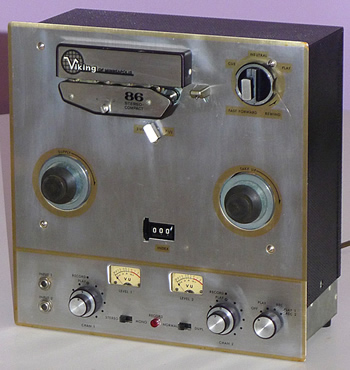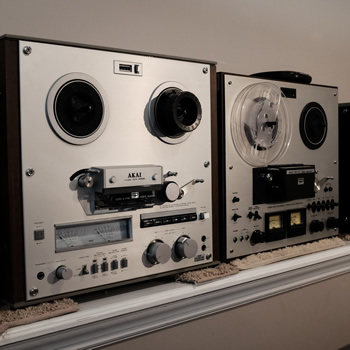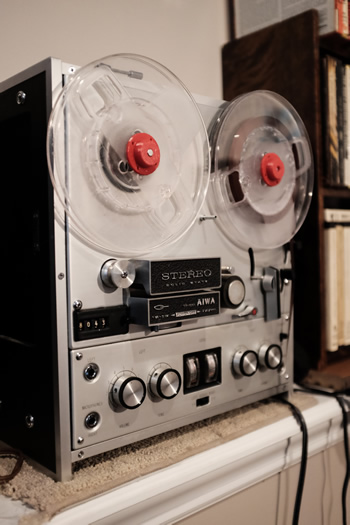Mysteries Of Life
Even as late as 2012, I was still spending a fair amount of time listening to well-worn prerecorded cassettes of my favorite bands from the 80s. Noting that there had been some recent re-masterings of their major label releases, I finally decided to replace those aging cassettes with CDs. I was expecting a step forward in audio quality especially since the re-mastering was done by the groups’ original engineers at fine facilities.
Sadly, the CD re-mastering didn’t quite measure up to the cassettes in some key areas. Yes, the new CDs were clearer and you could hear a lot more detail. But the dynamics and the real cutting edge sounds just weren’t present on the CDs. In most ways, the cassettes grab you more. The excitement and emotion is all there. The sound of the CDs was best described as flat.
Why are so many 30 and 35 year old cassettes more fun to listen to than re-mastered CDs even when some of the original engineers have a hand in things and even when the re-mastering is done by experts ?
I am invariably floored by how good so many of these cassettes now sound compared to the flattened dynamics of so much of the popular music that has been released in recent years. The cassettes just pop and jangle. They hop like a rabbit. The CDs all too often just lie there like a lazy dog.
Sometimes I joke, half seriously, that maybe it is Dolby B Noise Reduction - did Ray Dolby actually create the perfect EQ for rock and roll? Certainly playing the Dolby cassettes back without engaging the Dolby circuit provides just the right amount of boost at just the right frequencies. You still never pay attention to the hiss - and the edginess of the sound with Dolby ignored is usually just perfect, especially after 20 years of playback.
What are we doing wrong with compression? They must have compressed like crazy for the cassettes but somehow we used to know how to compress without taking all the life out. Why has this become a lost art? Why do even great engineers and producers now revert to such lifeless dynamics? The gear is so much better, so why does so much come out so flat and dull. And why can't engineers and producers hear how bad some of this stuff sounds in comparison to their own work with the same artists in a previous decade?
A favorite group that had charted with frequency in the mid-1980s went back into the studio in 2010/2011 for a new release with a producer they had used in their popular years. They recorded the tracks with an engineer who always does great work, in a top notch studio. The basic sound of the band hadn't changed. I wanted so much for this to be a great CD. But it was a major disappointment. I was baffled - with such a skilled production team, how could the end result be such a weak sounding CD that usually manages to castrates the band's dynamics?
How does this happen? Do we really believe this is what's needed to sell records today? Does anyone remember what a real snare sounds like? Why do cassettes of the same band from 1984 sound so much better than a 21st Century CD?
A few years ago I purchased a new and universally acclaimed CD by a major Nashville artist. It boasts the best performances and the best overall musicianship that one could imagine, recorded in wonderful studio facilities. I love the CD BUT sadly I think it is significantly degraded by a recording that, while thoroughly contemporary with no expense spared, simply is flat and lifeless, like so much done today. Compare it to so many recordings of similar music done in the 70s and 80s and even 90s and to my ears it just doesn't measure up. This is isn't about analog vs. digital or vintage gear. It is more about about how we hear and mix.
I have a stack of thoroughly modern and commercial digital recordings from Nashville done in the 1980s and 1990s where the guitars and steel guitar all sound so much more lively and dynamic than the sound that the same artists, producers and studios are putting out ten or fifteen years later.
It's getting pretty ridiculous when we can look back just 20-30 years and see even so recent a period with its relatively aged digital technology as a cut above what has been done over the past ten years, when we are literally drowning in great gear and talented personnel.
We're not making comparisons here with my much beloved golden decade of high-fidelity (1958-1968), so we can't attribute this situation solely to analog technology, vintage gear and minimalist recording techniques.
In response to an email I sent, I received the following comment from a highly respected artist/producer/engineer who enjoyed considerable success in the 1980s:
"I always go out of my way to pop the balloon of jokes that have to do with how terrible cassettes sound! This is because: they don’t! Cassettes are like so many things from the Olde Days, they usually sound sort of strong and full in a way that's exactly what's been missing from a lot of recorded music for years now.
Sort of like how old tape {1950s and 1960s} never develops "sticky shed" {the curse of mid-1970s Ampex 456}; - with cassettes it makes you think, "Well, they used to know how to do it..."!
Some of my more audio-oriented friends in bands are asking me if they really have to have their stuff mastered. And I know what they mean; increasingly I simply don't like the sound of mastering as it's practiced today by all kinds of well-meaning practitioners. I really don't know what it is! On one of the computers here we have a plug-in that's called Mastering Compressor, and whatever it does is exactly the Bad Sound we usually get now: It's loud, it's sort of crunchy and it's sort of dirty. Initially it is also exciting but you just know it's a sound that will wear thin very quickly! “
Shortly after I received this, I too had my first conversation with a younger musician where he expressed a real fear of what mastering could do to the product he was bringing out of the mixing session. He started commenting about how he and his friends just seem to have a common experience: they're really excited when they finish mixing but by the time they get around to repeatedly listening to the mastered final product, it seems to them that depth, space and especially dynamics have been altered producing a very carefully controlled two dimensional product that they all describe as "flat." So he, too, was asking - “If this is what mastering does, why do we do it?’’
Back to cassettes: Did they really sound all that good?
In 1993, Sony was pushing hard to get acceptance for their digital MiniDisc format. They trotted out a series of very brief and presumably well edited quotations from widely admired engineers (George Massenburg, Roger Nichols, Ken Pohlman and Tom Jung) in support of this format. A music writer for the NY Times, Edward Rothstein, penned his dissenting opinions in an article entitled "Beyond CD: Music Takes a Back Seat." (NY Times of 05/16/1993)
Among other things he noted that when comparing recordings made on MiniDisc and DCC recorders to those made on a Nakamichi cassette deck, the Nakamichi cassette recording was the clear winner: "For the price of an MD or DCC player, a cassette deck can produce a more musical sound."
Rothstein liked to refer to good recordings as "lifelike." But he acknowledged, with regret, that the LP and cassette were doomed formats. He felt that new formats would "codify an artificial and astringent sonic style" that he referred to as "embalmed." He concluded: "If listeners get too used to the embalmed quality of these innovations, eventually even concert halls and instruments will suffer. Some already do."
That was 25 years ago. What has happened to our ears since? Like I said - the mysteries of life. Don't throw out those old cassettes quite yet. Listen to them from time to time and wonder about what we knew then that we don't know now.
Fast forward to 2019. High quality blank cassettes are once again being manufactured by RTM/Mulann. Very good cassette decks often sell for a reasonable price on E-Bay. With a bit of maintenance these often can be restored to excellent performance. I currently enjoy working with 5 cassette decks from the 1980’s in my vintage hi-fi listening room. There’s still great fun to be had with this format!
It may seem counter to all reason, but quite a few of our younger enthusiasts will even record their CDs onto cassettes, finding that to their ears, the final listening experience in the cassette format is preferable.
*******************
There’s more to come! Pre-recorded open reel tapes have re-appeared in increasing quantity. RecordingTheMasters now lists a dozen or more sources for these on their website. For those who have 15ips capacity on their open reel decks, listening to a well-produced pre-recorded analog tape can be an eye-opening experience , albeit an expensive one. Nothing quite sounds like these!
Even at 7.5 ips, analog tape has the ability to astonish the listener. My collection of pre-recorded tapes, mostly over 50 years old, never fails to bring raves from listeners.
Vintage quarter-track machines with 7.5 and 3.75 speeds are relatively affordable if you buy the models that are limited to 7” Reels. They sound great and are fun to use. We are starting to refurbish some Teac, Aiwa and Akai machines that we are quite fond of.
In January 2020, we will begin to make these available to buyers on-line and at The Sound Parcel’s new retail space in the historic Simon Silk Mill complex in Easton, Pennsylvania, some 65 miles from NYC and Philadelphia.
For those doing their own recording in the open reel format, the renewed availability of popular BASF and AGFA tape formulations offers some very positive attributes compared to the products that were most frequently used in US recording studios.
I used Ampex 406 and 456 extensively in the 1970s but by the 1980s I began to look for tapes with less print-through, better slitting and winding characteristics and a less “hot” sound. Initially I switched to Scotch 250 but a persistent sales rep kept telling me to try AGFA PEM 468 and when I finally did, I found that it was a near perfect choice for me. It became the product of choice in my real-time tape duplication business. A natural sounding tape that ran well and stored well. Many archival specialists came to prefer it in their critical applications. I highly recommend you get a 7 inch roll of the SM 468 put it to the test.
Doug Fearn, the renowned designer of D.W. Fearn audio equipment, has kindly provided us with an account of his introduction to AGFA tape in the 1980's.
Download Doug Fearn's Introduction To Recording Tape
Lewis Frisch
Originally written in 2014/ Revised 2019
RecordingTheMasters open reel and cassette recording tapes are manufactured in France by Mulann Industries and distributed by way of Mulann USA ( Brooklyn NY) and their network of dealers.
www.recordingthemasters.com
Bedford Vintage Hi-Fi will be displaying some of our restored tape recorders at The Sound Parcel’s new showroom which will open in late 2019 at the historic Simon Silk Mill in Easton, Pennsylvania. The Sound Parcel is a stocking dealer for all of the RecordingTheMasters analog tape products and accessories.
www.thesoundparcel.co
Lewis Frisch owned and operated the South’s first and premier real-time tape duplication facility, Soundd Technical Services, from 1980-1988. From 1980 through 1984 he was employed by Soundd Investment, an Atlanta based company that originally focused on serving the needs of recording tape enthusiasts throughout the US. He helped guide their expansion into the professional markets for audio and video media and studio supplies, while also managing their retail outlet “The Tape Warehouse.” He still surrounds himself with a dozen open reel recorders of various types and vintages.

Viking 86 as used at WBBC-AM, New Milford CT. 1964

Akai GX-255

Akai GX-230D

